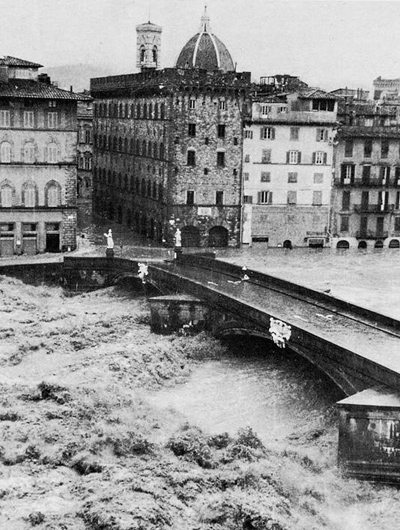The 1966 Flood of the River Arno in Florence killed many people and damaged or destroyed millions of masterpieces of art and rare books in Florence. It is considered the worst flood in the city’s history since 1557.
With the combined effort of Italian citizens and foreign donors and committees, or angeli del fango (“Mud Angels”), many of these fine works have been restored. New methods inconservation were devised and restoration laboratories established. However, even decades later, much work remains to be done.
November 3, 1966
After a long period of steady rain, the Levane and La Penna dams in Valdarno began to emit more than 70,629 cubic feet (2,000.0 m3) of water per second toward Florence.
At 2:30pm, the Civil Engineering Department reported “‘an exceptional quantity of water.'”
Cellars in the Santa Croce and San Frediano areas began to flood.
Police received calls for assistance from villagers up the Arno Valley.
The flood’s first victim, a 52 year old workman, died while trying to reach a crumbling aqueduct.
November 4, 1966
At 4:00am, engineers, fearing that the Valdarno dam would burst, discharged a mass of water that eventually reached the outskirts of Florence at a rate of 37 miles per hour.
At 7:26am, the Lungarno delle Grazie cut off gas, electricity and water supplies to affected areas.
By 8:00am, army barracks were flooded.
By 9:00am, hospital emergency generators (the only source of electrical power remaining) failed.
Landslides obstructed roads leading to Florence, while narrow streets within city limits funneled floodwaters, increasing their height and velocity.
By 9:45am, the Piazza del Duomo was flooded.
The powerful waters ruptured central heating oil tanks, and the oil mixed with the water and mud, causing greater damage.
Florence was divided in two, and officials were unable to immediately reach citizens of the city past the Piazza Michelangelo.
At its highest, the water reached over 22 feet (6.7 m) in the Santa Croce area.
By 8:00pm, the water began to lower.
Impact
The flood has had a lasting impact on Florence, economically and culturally. City officials and citizens were extremely unprepared for the storm and the widespread devastation that it caused. There were virtually no emergency measures in place, at least partially due to the fact that Florence is located in an area where the frequency of flooding is relatively low. In fact, approximately 90% of the city’s population were completely unaware of the imminent disaster that would befall them as they were sleeping during the early hours of November 4, 1966.
Residents were set to celebrate their country’s World War I victory over the Austrians on November 4, Armed Forces Day. In commemoration, businesses were closed and many of their employees were out of town for the public holiday. While many lives were likely spared as a result, the locked buildings greatly inhibited the salvaging of valuable materials from numerous institutions and shops, with the exception of a number of jewellery stores whose owners were warned by their nightwatchmen.
Tragically, 5,000 families were left homeless by the storm, and 6,000 stores were forced out of business. Approximately 600,000 tons of mud, rubble and sewage severely damaged or destroyed numerous collections of the written work and fine art for which Florence is famous. In fact, it is estimated that between 3 and 4 million books/manuscripts were damaged, as well as 14,000 movable works of art.
Artist Marco Sassone, in an 1969 interview, recalled the impact of the flood on Florence’s residents: “The only thing you could do was watch and be helpless. Nature was master…the women became crazy with fear. They began throwing things from the windows and screaming ‘who is going to save my children?'” It was reported that 101 people lost their lives in the flood waters.
Leslie Halloran
Please check out my website at: www.lihdesigns.net
“A frog in the well does not know the sea.” Japanese Proverb

0 Comments